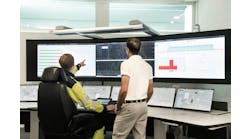Process safety panelists including (L to R) consultant Herman Storey, Dennis Zetterberg of Chevron, and Scott Mourier of Dow Chemical provided updates about IEC 61511, ISA 100 and other safety standards, and charted the recent efforts of their committees and working groups.
If designing, maintaining and continuously updating safety instrumented systems (SIS) is the most important job of SIS professionals, then the second most important task of the SIS community is maintaining and continuously updating the changeable standards on which their process safety programs are based."The most important aspect of safety standards is that they give practitioners a common and uniform vocabulary for carrying out their safety efforts," said Dr. Farshad Hendi, safety practice leader, Americas and Europe, Schneider Electric. "They also enable good engineering practices, and provide a framework and baseline for benchmarking."
To update users on the latest updates and direction of SIS standards efforts, Hendi moderated an expert panel at this week’s EcoStruxure Triconex User Group conference in Galveston, Texas. Its members included Herman Storey, CTO, Herman Storey Consulting; Dennis Zetterberg, safety systems team lead for Chevron Energy Technology Co.; and Scott Mourier, process automation SIS expertise area leader, Dow Chemical Co.
"It's a very exciting time for process safety because of the changes we're seeing to IEC 61511 and the efforts of its working groups, and because IEC 61508 is going to undergo a major revamp soon," added Hendi. "The same goes for the ISA 100 and ISA 108 standards."
IEC 61511 survey and report
Hendi reminded the audience that just as the first edition of IEC 61511: Functional Safety—Safety Instrumented Systems (SIS) for the Process Industry Sector, was released in 2003, and later clarified some confusing sections as part of its second edition released in 2016, its developers are continuing to refine the standard with further input from end users.
"Many aspects of IEC 61511 are good, but some need to be made clearer," explained Hendi. "The second edition tried to shift more towards functional safety management, and add security, allocation of safety functions, and address architectural constraints. However, after the second edition was published, there were more reactions to it. As a result, its committee decided to conduct a survey to gather more feedback." This online survey went out to potential respondents worldwide, and garnered responses from more than 250 end users and other process safety practitioners, mainly in the U.S., Europe and Australia.
Zetterberg reported the IEC 61511 committee sought to learn what parts of the standard were still confusing for users and what still required clarification. "So, we began developing a technical report, TR-IEC 61511-4 that would highlight all the clauses, including the rational for why they were put in, and highlight the differences between the first and second editions," said Zetterberg. "It also had a brief explanation of the typical process sector approaches to the application of each primary clause."
Though specific results haven't been released beyond the IEC 61511 committee and the survey's respondents yet, Zetterberg reported they're generally seeking better definitions for the standard as it compares to IEC 61508, and answers to many questions about protection layers, architectural constraints, HAZOPS and risk assessment procedures, and hazardous safety lifecycles. "For example, the respondents want to know more about functional safety audits, how to get process safety right, and how to do validation to make sure they've done the right things," added Zetterberg.
Hendi added, "TR-IEC 61511-4 is also trying to provide some simpler language when talking about the standard, such as what's the rationale behind the clauses, and addressing misconceptions that can rise when moving from the first to second editions."
Storey reported that TR-IEC 61511-4 is less than 50 pages, and that the IEC 61511 committee is presently in the process of reviewing it. He added that it's scheduled to be released to the worldwide IEC 61511 committee in December for review, and the editorial process may be completed in mid-2019.
ISA 84 and technical reports
Similarly, the panel covered how the ISA 84 standard, launched in 1996, evolved to become IEC Mod 61511 in 2004, and was just designated as ISA 61511 earlier this year.
"Many process safety efforts have many of the same members, but not a lot of collaboration," said Mourier. "As a result, there's going to be more collaboration as we go forward to find the best practices for application-specific areas. ISA will continue to have a key role, including collaboration within the ISA 84 committees developing technical reports about clauses in the standards, or about lifecycle and maintenance calculations."
Zetterberg added, "If anyone wants to have input into the third edition, I'd recommend getting involved at ISA.org. If anyone just wants to make comments, they can submit them, and we'll make they get included."
One of the main technical reporting efforts is TR 84.00.05: Guidance on the Identification of Safety Instrumented Functions (SIF) in Burner Management Systems (BMS). The panel reported the committee is researching how some ISA 61511 principles may be applied to existing BMS equipment. "The effort here is informative to see if we can apply performance-based material from ISA 84, but this isn't prescriptive," said Zetterberg. "We met in May, and already have a lot of feedback. The next step is to revise the scope of TR 84.00.05, and try to collaborate with other standards, but we're not saying what it should have."
Another primary technical report area is TR 84.00.07, Guidance on the Evaluation of Fire, Combustible Gas and Toxic Gas System Effectiveness, which its committee members have been working on for two years, and includes items such as the location and testing of detectors. Zetterberg reported it's also not meant to replace prescriptive requirements, but just to help users mitigate risk.
Likewise, Storey added that TR 84.00.08,Guidance for Application of Wireless Sensor Technology to Non-SIS Independent Protection Layers, consists of a broad push by users that want to implement wireless solutions for some safety-related tasks, such as tank overflow monitoring applications. "This report is done and published, but it's still a complicated issue because it's been hard for users to evaluate what to do without an existing standard," explained Storey. "Still, they'll decide what to do next soon."
ISA 100 and the Industrial IoT
Storey reported that even though the ISA 100.11a wireless standard has been published as IEC 62734, its developers are presently mulling how to extend it to help users better integrate Industrial Internet of Things (IIoT) solutions and expected benefits.
"The Wireless Compliance Institute is coordinating this effort, so wireless functions will be able to run on any available technology, and also have different layers on top of ISA 100,11a," explained Storey. "We're already done technical reports on backhaul and wireless management technologies, and one of the main lessons from all this is: if you want safe and secure networks, then you've got to manage them."
Similarly, Story added that ISA 108/IEC 63082: Intelligent Device Management, is seeking to achieve and sustain functional performance requirements for a variety of smart components, which includes how to diagnose, calibrate and test them.
The editors of Control were on site at the 2018 Triconex User Group Conference to bring you breaking news, innovations and insights from the event. Now that the event is over, the editors have put together an event report featuring the top news. Get your copy today.





